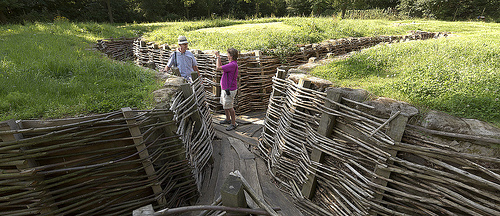1. Last Post at Ypres’ Menin Gate: One shouldn’t miss the Last Post at Ypres’ Menin Gate, a short tribute paid every night at 8pm, for the last 86 years by buglers from the fire brigade. It is their way to honor those who died in action to secure Belgium’s freedom.
2. Tyne Cot: The Tyne Cot Commonwealth War Graves Commission cemetery is the largest cemetery in the world, with 11,956 burial plots. It is located just a few miles away from Ypres, somewhere near Passchendaele. Another good place to visit would be the Passchendaele museum in Zonnebeke castle.
3. In Flanders Fields: Based in Cloth Hall, where British wool used to be stored in medieval times, the new In Flanders Fields museum centers on real soldiers who fought and lost their lives in the war and exposes the war in a more personal, human way. You can easily identify how many people sharing your surname were killed in the war; for example 731 British people called Barrett lost their lives in the First World War.
4. Hill 62: The Hill 62 museum is one of the most impressive attractions of the First World War, mainly because of the perfectly preserved trenches and the most touching photographs of people, dead and alive on the front line. Near the Hill 62 museum you can find the Hooge Crater museum, which has numerous collections of war weapons and material and a lovely tea room where you can stop for a drink.
5. Lille: Located only a half an hour drive from Ypres and very close to the Belgian border, the French city takes you to some major Somme battlefields, among which are Amiens and Arras. In 1915, a group of 5 people who were part of a resistance group, were killed by the Germans for sharing information with the British forces, the Mail Online reports.
6. Agny cemetery near Arras: Poet Edward Thomas, who joined up the Army aged 37 and left his wife and three children to go to war, who turned down a job as an instructor in Britain because he believed his country needed his effort and protection, who’s heart stopped on Easter Monday 1917, while watching a shell which passed so close to him it left him breathless, is buried in Agny’s military cemetery.
7. Wellington Quarry, Arras: A lovely museum located in Arras, showing the braveness and kindness of all who were involved in the conflict.
8. Wilfred Owen: You can go on an amazing tour, In The Footsteps Of Wilfred Owen, which takes people to Ors and through the last days of the poet’s life. The house where he wrote his last letter home has been converted into a museum.
9. The Battle of Fromelles: A new museum, commemorating the 1916 Battle of Fromelles, in which over 5,000 Australian troops lost their lives in only one day, is due to open at the end of April this year.
10. Imperial War Museum: After a six-month break, the Imperial War Museum is finally opening its doors again in July. The museum is expected to be a major attraction during the centenary.
